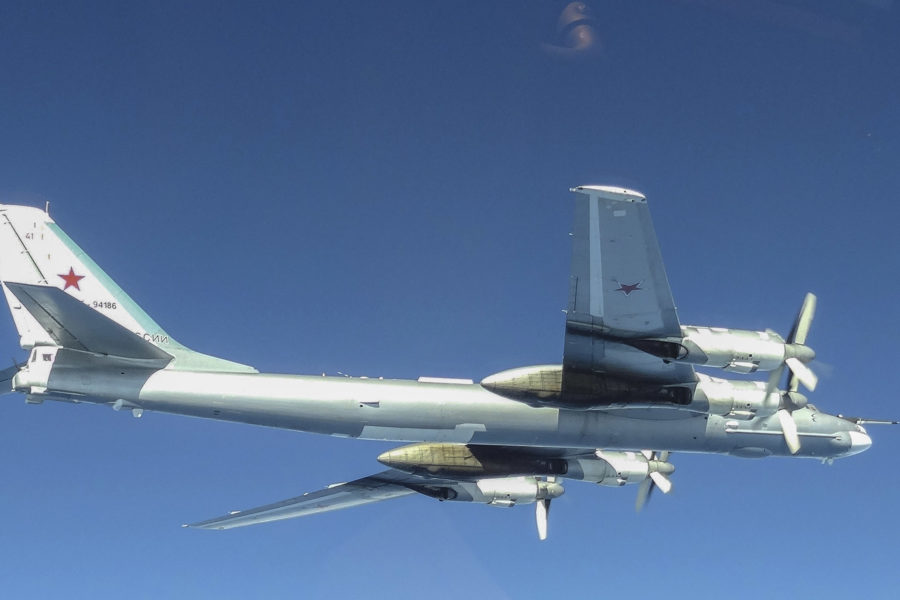A pair of Russian strategic bombers flew near U.S. and Canadian airspace last week before turning back short of the countries’ Air Defense Identification Zone, the head of North American Aerospace Defense Command and U.S. Northern Command revealed March 14.
Air Force Gen. Gregory M. Guillot also offered more details on his warning that Chinese warplanes could start flying near or in the U.S. ADIZ this year during an appearance before the Senate Armed Services Committee.
NORAD regularly detects Russian aircraft operating in the ADIZ—buffer regions that extend beyond territorial boundaries, covering airspace hundreds of miles from the coastline that nations use to track approaching aircraft. However, Guillot specified that this latest incident was different in that the bombers, Tu-95 “Bears,” were approaching from the northeast and not toward Alaska, where most such incidents occur.
“We’ve had some success working with NATO and European Command on the … northeast approach,” Guillot said. “Just last week, for the first time in over two years, the Russians sent two ‘Bear’ bombers down along that avenue through what we call the ‘GIUK gap,’ Greenland, Iceland, and the United Kingdom, approaching the Canadian and the United States Air Defense Identification Zones.”
The Tu-95 is a strategic, long-range bomber capable of carrying diverse weapons payloads. In February, NORAD reported three occasions of Russian aircraft flying in the Alaskan ADIZ without detailing the aircraft types, but Russian military officials disclosed that two of the four planes in one incident were Tu-95s, according to Reuters.
NORAD occasionally scrambles fighters to intercept those aircraft and escort them out of the ADIZ. In this latest incident, that wasn’t needed as U.S. and Canadian fighters were already in the air, Guillot said.
“We didn’t have to intercept them because we had aircraft flying to the point where we would intercept them before they crossed the identification zone, and the Russians turned around prior to reaching that zone,” Guillot said.
Guillot said NORAD kept its eyes on the bombers throughout their flight, crediting collaborative data sharing with allies via the U.S. European Command and NORTHCOM, particularly with Norway.
While the Russian bombers did not fly near Alaska this time, Guillot noted that China’s People’s Liberation Army may soon join Russia in approaching the ADIZ in that region.
“What I’ve seen is a willingness and a desire by the Chinese to act up there (the Artic),” Guillot said. “I expect to see air activity in the Alaska part of the Arctic as soon as this year, potentially. It’s a very big concern of mine.”
Guillot previously told the House Armed Services Committee that he was anticipating Chinese airplanes operating near the U.S. ADIZ sometime this year, but he did not specify what region.
Both Russia and China continue to present major threats to the U.S. homeland, Guillot said.
Russia has made substantial investments in advanced guided-missile submarines, hypersonic glide vehicles, ICBMs, and developmental systems like nuclear torpedoes and nuclear-powered cruise missiles, despite heavy losses of its ground forces in Ukraine.
“Russia retains the world’s largest stockpile of strategic and non-strategic nuclear weapons, along with significant capacity to strike inside North America with air and sea launch precision conventional weapons,” Guillot said.
According to the National Air and Space Intelligence Center’s senior analyst, China possesses the world’s leading hypersonic arsenal, which Guillot repeatedly described as “the most destabilizing weapon.”
Given the threat, Guillot emphasized the need for NORAD and NORTHCOM to have over-the-horizon radar and tracking systems to bridge awareness gaps.
“There are some gaps that will be manifesting in the near future,” Guillot said. “Those are currently scheduled to be addressed by the over-the-horizon radar and by the HBTSS, which is the hypersonic and ballistic tracking space system.”
Another area of concern Guillot highlighted was the need to train and equip backup forces to handle the Arctic’s extreme weather.
“The backfill forces are probably very well trained, but they’re not equipped and they haven’t trained in that environment,” Guillot said. “So, anything that we could do for the supplementing forces or the backfill forces that would go into the Arctic, training them in either in the Arctic environment or in something that would replicate that will be very important. Not only to give them those skills, but to identify what are the pieces of kit and equipment that we need to develop and issue, so they could seamlessly operate in that strategic environment.”
